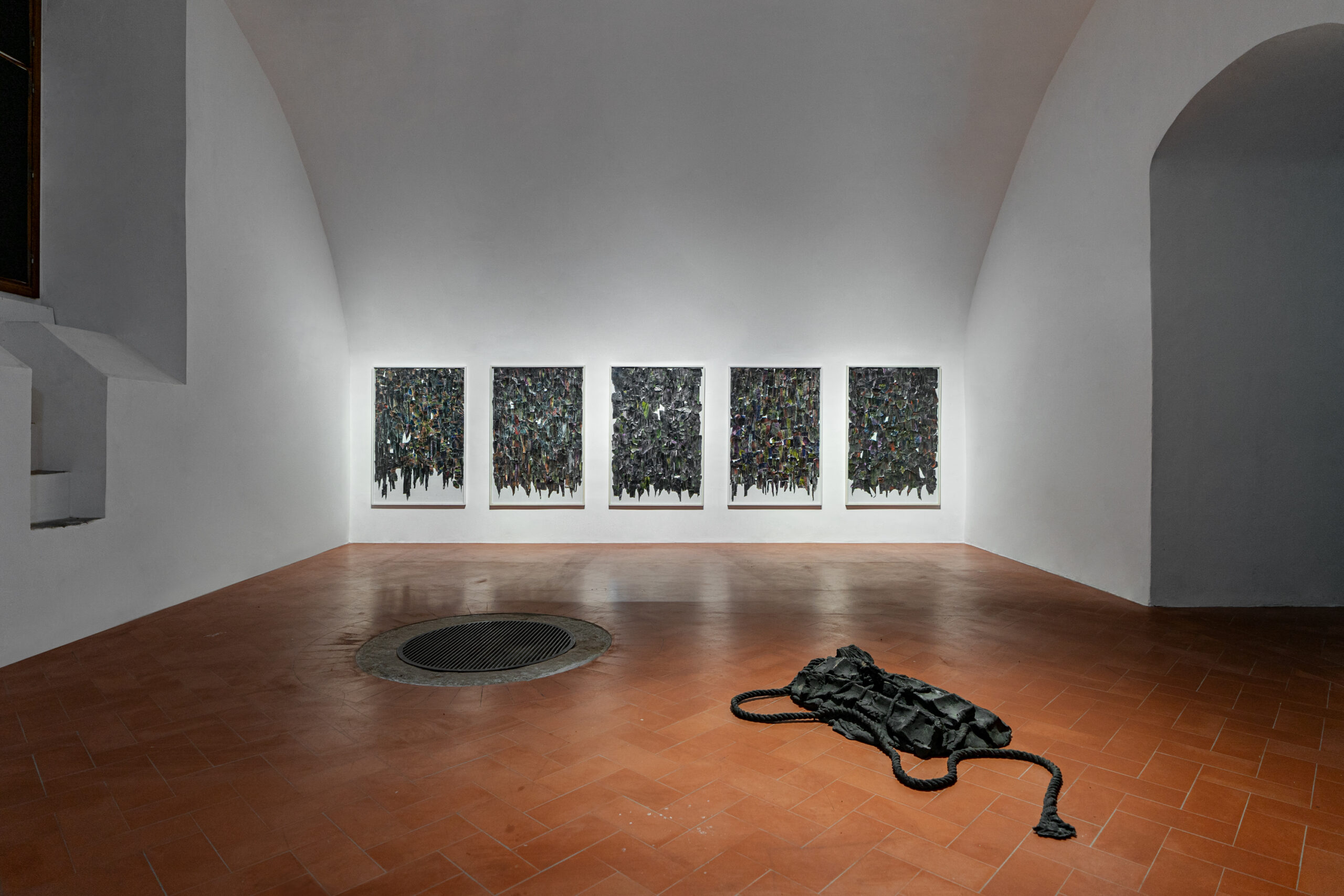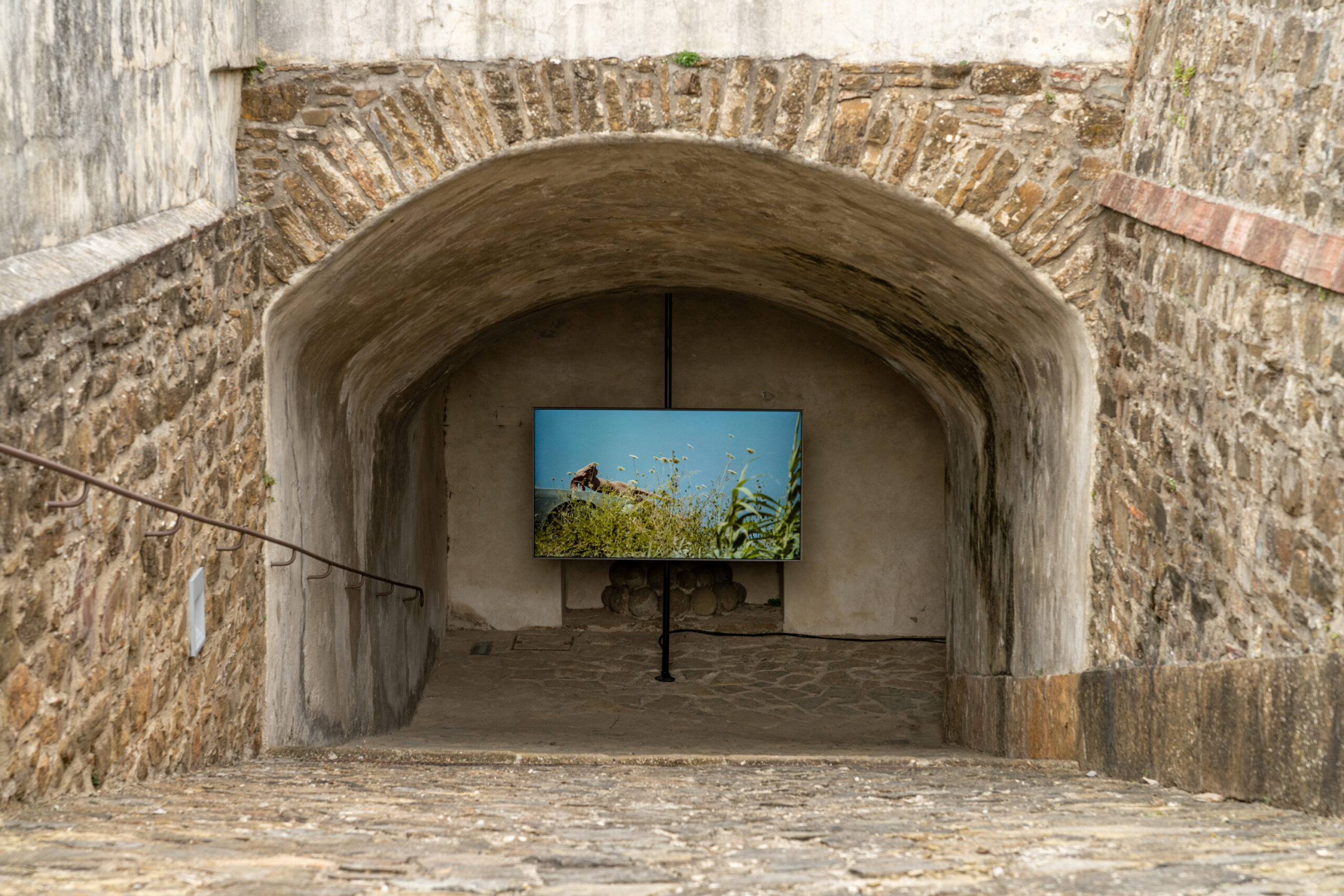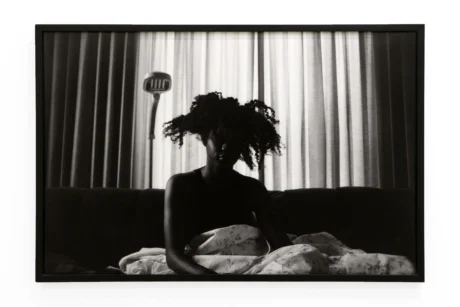
In Palazzo Vecchio’s Salone dei Cinquecento, a still-functioning city hall in Florence, opulence abounds. This historical site, adorned with Giorgio Vasari’s battlefield frescoes and sculptures depicting bodies in dynamic poses, now sets the stage for Nico Vascellari’s performance, Alessio. Considered one of the most important Italian artists of his generation, Vascellari’s artistic output – broadly encompassing painting, sculpture, sound, performance, film, installation, fashion design and music – explores human’s vital relationship with nature.
In his performance, Alessio, Vascellari records the life of an autistic man as a contemplation on societal acceptance and personal reflection. The film captures Alessio, a young man in Rome, as he stands outside of a bar mimicking the sounds of birds whistling. The environment radiates calm as time unfolds leisurely and people go about their everyday routines. One by one, a convoy of forty dancers enters the Salone and performs, exploring the inherent instinctual quality of Alessio’s gestures. Vascellari underscores the importance of respectful engagement and the delicate balance between tradition and innovation.
Returning to Florence after a 20-year hiatus, Vascellari challenges traditional art spaces with a performance at the Palazzo Vecchio, alongside a permanent sculpture at Piazza della Signoria. At the Forte di Belvedere, he presents animals with engine limbs and ligaments cast in aluminium outside, whilst films of racing cars repeatedly crashing into themselves play in alcoves. More than forty car manufacturers use the image of an animal as their logo. “Every hundred or more years, mankind invents something beyond its potential,” Vascellari tells me, asserting that technology dehumanises and disrupts the environment, but art rekindles our sensitivity and fosters harmony with nature.
I am chatting with Vascellari in the cafe at the Museo Novecento, overlooking the piazza to the Santa Maria Novella.

Sofia Hallström: Your performances often involve intense physicality and endurance. How does your body become a tool for artistic expression, and what challenges and rewards do you experience in this aspect of your practice?
Nico Vascellari: Performance felt like a natural development for what I was doing previously as a singer for a band. Being a singer was not just making music; but it was a way of being active politically. It’s a way to express ideas. I felt that this experience as a singer taught me a lot about moving, dealing with the space, dealing with the audience, dealing with the surroundings, and dealing with the feeling you share with your audience in order to create an atmosphere.
Sofia Hallström: Nature and primal elements seem to play a significant role in your art. Could you elaborate on the symbolism and significance of these elements in your work?
Nico Vascellari: As humans, I think we tend to contemplate nature rather than really being part of it. The work deals with that. This concept explores the notion that, despite our best efforts, we tend to position ourselves as being superior to nature by default. This is not an environmental claim. Look at where we are right now: there are no trees. I feel like there are these sunken feelings inside of us, these fossils of experiences, stuff that is just there, buried, but present. It’s about trying to dig out aspects of what we are.
Sofia Hallström: Alessio was the first performance that you yourself have not physically taken part in. How do you prepare the performers? What is the rehearsal experience like?
Nico Vascellari: At first, I didn’t say much about the work. I just asked them to repeat [the movements] of what they were seeing. Later on, I started to explain more and give them directions in order for them to step out of their character and become someone else. The performance is conceived in this way: it starts off as an imitation of a movement, and then you begin to see each performer as an individual. Gradually, you begin to notice the differences between each of them. It’s a chorus. You start to notice that each performer has their own way of interpreting the movements.

Sofia Hallström: Your practice is broad and ranges across different mediums. I’m interested in your studio process. The process of making a large-scale bronze sculpture in a foundry is a very different approach to working with performers. How do you approach the intersection of all of these artistic mediums?
Nico Vascellari: The approach is more or less always the same, even though the mediums are so different. I started making work when I was travelling on tour with a band that I was part of. On the days off or during the day, rather than going to the record store or the skate park, like the rest of the band, I started to go to museums. I always did before with my parents. I was taking all these notes about the artists and artworks that I liked. At night, we played gigs in squats, youth centres, people’s living rooms, or garages. I was travelling all over Europe. All of a sudden, I started to meet true experiences; for example, in the museum, I never felt scared. At the band performances, I started to think to myself, ‘I wish we could move the stage, or I wish we could have different lights. I wish I could see people. I wish the audience could enter from the window’, and that’s where my practice started. I needed to combine all of these elements, and that’s still how I approach the work. It’s a very personal way of dealing with the tools that I have.
It’s mostly the idea behind the work that leads me to try different materials. It’s the idea that forces me to choose a technique. I feel right now that some of the few things that we are very privileged to have are the materials and the resources out there. Sometimes, not knowing so much about a certain material can lead to new discoveries.
Sofia Hallström: Are there any geographical influences that have left a mark on your work?
Nico Vascellari: Yes, several of them. Right now, I feel that the travels that I had in Africa in the last few years definitely left a mark in the way that I approach materials. For certain, my work keeps coming back to my hometown, Vittorio Veneto. I keep on going back there to investigate the forest, the history, the legends, stories and traditions. I spent time in the mountains growing up.
Sofia Hallström: Any notable changes in your artistic practice or themes you’d like to discuss?
Nico Vascellari: I don’t currently have a specific vision for my future work, but this performance opens new possibilities. I also see strong connections between Alessio and my past work. For instance, in a video created shortly after the performance, I aimed to be present without revealing myself physically. I attached a camera to my hand and dropped parts of a drum kit down a mountain, and trusted my body as I followed them. While watching these videos, you can sense my presence without seeing me. Many of my other works also delve into themes explored in Alessio.

Sofia Hallström: The sculptures are created by casting animal forms along with machinery components such as engines. Could you explain your casting process for sculptures that combine animal forms with machinery?
Nico Vascellari: Initially, I created a series of sculptures that directly represented the animals featured in the films alongside their engines while they were still connected. Conceptually, this approach felt like the ideal direction for the work. It perfectly aligned with my vision. However, when these sculptures stood alone, visually, they didn’t possess the same strength as the concepts they were meant to convey. So, I decided to go back to the drawing board. I cast the animals and their engines separately, and once I had the wax casts, I began to cut and combine them, mixing the elements together to create a more compelling and visually impactful result.
Sofia Hallström: The layering in your work is intriguing, especially the overlay of animals with humans. Can you elaborate on this?
Nico Vascellari: Layering is definitely something that is part of my practice. The work deals with what I call forces of experiences: stuff that is buried and sometimes forgotten inside ourselves, and this is what I am interested in investigating.

Sofia Hallström: Do you have a specific intention or desired response that you aim for when the audience experiences your performance?
Nico Vascellari: Not necessary. The important thing is that they feel something. What they feel is not so relevant to me. But the important thing is that they feel. So, it is not important what you communicate, but rather that you manage to communicate.
Sofia Hallström: How do you view the political aspect of your work in addressing societal issues?
Nico Vascellari: I do hope that the work has a political approach and a philosophical point of view. When you watch Alessio, it is a window, a possibility of seeing one world, but there are millions of other worlds, millions of other ways of living experiences, of experiencing reality. I do not wish to say or to do something right or do something wrong. I’m interested in investigating the world, but I want the work to be specific and personal.
Words by Sofia Hallström. Photography by Ela Bialkowska OKNO studio. Courtesy the artist and Museo Novecento Firenze.





